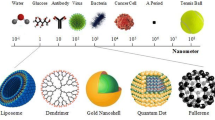Abstract
Silver nanoparticles are used in a wide range of consumer products such as clothing, cosmetics, household goods, articles of daily use and pesticides. Moreover, the use of a nanoscaled silver hydrosol has been requested in the European Union for even nutritional purposes. However, despite the wide applications of silver nanoparticles, there is a lack of information concerning their impact on human health. In order to investigate the effects of silver nanoparticles on human intestinal cells, we used the Caco-2 cell line and peptide-coated silver nanoparticles with defined colloidal, structural and interfacial properties. The particles display core diameter of 20 and 40 nm and were coated with the small peptide l-cysteine l-lysine l-lysine. Cell viability and proliferation were measured using Promegas CellTiter-Blue® Cell Viability assay, DAPI staining and impedance measurements. Apoptosis was determined by Annexin-V/7AAD staining and FACS analysis, membrane damage with Promegas LDH assay and reactive oxygen species by dichlorofluorescein assay. Exposure of proliferating Caco-2 cells to silver nanoparticle induced decreasing adherence capacity and cytotoxicity, whereby the formation of reactive oxygen species could be the mode of action. The effects were dependent on particle size (20, 40 nm), doses (5–100 μg/mL) and time of incubation (4–48 h). Apoptosis or membrane damage was not detected.







Similar content being viewed by others
References
Ahamed M, Karns M, Goodson M, Rowe J, Hussain SM, Schlager JJ, Hong Y (2008) DNA damage response to different surface chemistry of silver nanoparticles in mammalian cells. Toxicol Appl Pharmacol 233(3):404–410 (Epub 2008 Sep 27)
Bouwmeester H, Poortman J, Peters RJ, Wijma E, Kramer E, Makama S, Puspitaninganindita K, Marvin HJP, Peijnenburg AACM, Hendriksen PJM (2011) Characterization of translocation of silver nanoparticles and effects on whole-genome gene expression using an in vitro intestinal epithelium coculture model. ACS Nano 5(5):4091–4103 (Epub 2011 Apr 20)
Carlson C, Hussain SM, Schrand AM, Braydich-Stolle LK, Hess KL, Jones RL, Schlager JJ (2008) Unique cellular interaction of silver nanoparticles: size-dependent generation of reactive oxygen species. J Phys B 112:13608–23619
Cha K, Hong HW, Choi G, Lee MJ, Park JH, Chae HK, Ryu G, Myung H (2008) Comparison of acute responses of mice livers to short-term exposure to nano-sized or micro-sized silver particles. Biotechnol Lett 30(11):1893–1899 (Epub 2008 Jul 5)
Chaudhry Q, Schotter M, Blackburn J, Ross B, Boxall A, Castle L, Aitken R, Watkins R (2008) Applications and implications of nanotechnologies for the food sector. Food Addit Contam 25(3):241–258
EFSA (2008) Inability to assess the safety of a silver hydrosol added for nutritional purposes as a source of silver in food supplements and the bioavailability of solver from this source based on the supporting dossier. EFSA J 884:1–3
Graf P, Mantion A, Foelske A, Shkilnyy A, Masic A, Thünemann AF, Taubert A (2009) Peptode-coated silver nanoparticles: synthesis, surface chemistry, and pH-triggered, reversible assembly into particle assemblies. Chem Eur J 15(23):5831–5844
Haase A, Arlinghaus HF, Tentschert J, Jungnickel H, Graf P, Mantion A, Draude F, Galla S, Plendl J, Goetz ME, Masic A, Meier W, Thünemann AF, Taubert A, Luch A (2011) Application of laser postionization secondary neutral mass spectrometry/time-of-flight secondary ion mass spectrometry in nanotoxicology: visualization of nanosilver in human macrophages and cellular responses. ACS Nano 5(4):3059–3068 (Epub 2011 Apr 2)
Kawata K, Osawa M, Okabe S (2009) In vitro toxicity of silver nanoparticles at noncytotoxic doses to HepG2 human hepatoma cells. Environ Sci Technol 43(15):6046–6051
Kim YS, Kim JS, Cho HS, Rha DS, Kim JM, Park JD, Choi BS, Lim R, Chang HK, Chung YH, Kwon IH, Jeong J, Han BS, Yu IJ (2008) Twenty-eight-day oral toxicity, genotoxicity, and gender-related tissue distribution of silver nanoparticles in Sprague-Dawley rats. Inhal Toxicol 20(6):575–583
Kim WY, Kim J, Park JD, Ryu HY, Yu IJ (2009a) Histological study of gender differences in accumulation of silver nanoparticles in kidneys of Fischer 344 rats. J Toxicol Environ Health A 72(21–22):1279–1284
Kim Y, Suh HS, Cha HJ, Kim SH, Jeong KS, Kim DH (2009b) A case of generalized argyria after ingestion of colloidal silver solution. Am J Ind Med 52(3):246–250
Kim YS, Song MY, Park JD, Song KS, Ryu HR, Chung YH, Chang HK, Lee JH, Oh KH, Kelman BJ, Hwang IK, Yu IJ (2010) Subchronic oral toxicity of silver nanoparticles. Part Fibre Toxicol 7:20
Klenow S, Pool-Zobel LB, Glei M (2009) Influence of inorganic and organic iron compounds on parameters of cell growth and survival in human colon cells. Toxicol In Vitro 23:400–407
Lampen A, Bader A, Bestmann T, Winkler M, Witte L, Borlak JT (1998) Catalytic activities, protein- and mRNA-expression of cytochrome P450 isoenzymes in intestinal cell lines. Xenobiotica 28(5):429–441
Nowrouzi A, Meghrazi K, Golmohammadi T, Golestani A, Ahmadian S, Shafiezadeh M, Shajary Z, Khaghani S, Amiri AN (2010) Cytotoxicity of subtoxic AgNP in human hepatoma cell line (HepG2) after long-term exposure. Iran Biomed J 14(1–2):23–32; (Project on emerging nanotechnologies) 2010 Analyses available: http://www.nanotechproject.org
Wright JB, Lam K, Hansen D, Burrell RE (1999) Efficacy of topical silver against fungal burn wound pathogens. Am J Infect Control 27(4):344–350
Wright JB, Lam K, Buret AG, Olson ME, Burrell RE (2002) Early healing events in a porcine model of contaminated wounds: effects of nanocrystalline silver on matrix metalloproteinases, cell apoptosis, and healing. Wound Repair Regen 10(3):141–151
Acknowledgments
We thank Alexandre Mantion for providing the peptide-coated silver nanoparticles.
Conflict of interest
I work at the Federal Institute for Risk Assessment (BfR). The BfR is independent in its scientific assessment and research work. I declare that I have no conflict of interest.
Author information
Authors and Affiliations
Corresponding author
Additional information
This article is published as a part of the Special Issue “Nanotoxicology II” on the ECETOC Satellite workshop, Dresden 2010 (Innovation through Nanotechnology and Nanomaterials + Current Aspects of Safety Assessment and Regulation).
Rights and permissions
About this article
Cite this article
Böhmert, L., Niemann, B., Thünemann, A.F. et al. Cytotoxicity of peptide-coated silver nanoparticles on the human intestinal cell line Caco-2. Arch Toxicol 86, 1107–1115 (2012). https://doi.org/10.1007/s00204-012-0840-4
Received:
Accepted:
Published:
Issue Date:
DOI: https://doi.org/10.1007/s00204-012-0840-4




